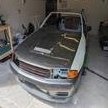Hicas?
Announcements
-
Similar Content
-
Latest Posts
-
Not sure the US can import anything other than the C34 Stagea's, but if you can and you need to to tow, DO NOT under any circumstances get an M35 Stagea. If it is just as a family car and your country/state allows it, absolutely and definitely get an M35 (3.5L if possible as it is effectively a 350Z) over a C34.
-
Punch your VIN (nm35-xxxxxx) into Amayama.com You can see everything there quite easily.
-
Thanks for that, I'll check it all out. I can always do the brakes last anyway if its a problem. The 16's are super cool, if they do fit I'll cruise around with them for a bit.
-
Well, that's kinda the point. The calipers might interfere with the inside of the barrels 16" rims are only about 14" inside the barrels, which is ~350mm, and 334mm rotors only leave about 8mm outboard for the caliper before you get to 350, And.... that;s not gunna be enough. If the rims have a larger ID than that, you might sneak it in. I'd be putting a measuring stick inside the wheel and eyeballing the extra required for the caliper outboard of the rotor before committing to bolting it all on.







Recommended Posts
Create an account or sign in to comment
You need to be a member in order to leave a comment
Create an account
Sign up for a new account in our community. It's easy!
Register a new accountSign in
Already have an account? Sign in here.
Sign In Now